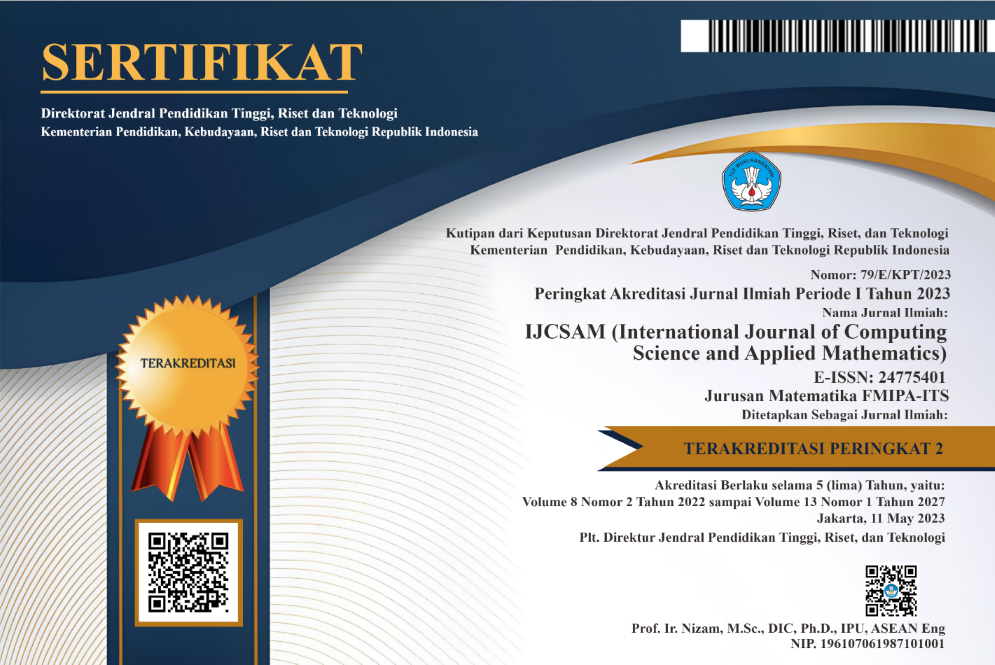Stability and Bifurcation Analysis of Time Delayed Prey-Predator System with Holling Type-III Response Function
Abstract
Keywords
Full Text:
PDFReferences
“Predator-prey dynamics: Lotka-volterra,” http://www.tiem.utk.edu/gross/bioed/bealsmodules/predator-prey.html, accessed: 1999-01-01.
A. Gasull, R. Kooij, and J. Torregrosa, “Limit cycles in the hollingtanner model,” Publicacions Matematiques, pp. 149–167, 1997.
T. Kar, “Stability analysis of a prey–predator model incorporating a prey refuge,” Communications in Nonlinear Science and Numerical Simulation, vol. 10, no. 6, pp. 681–691, 2005.
S. Jana, M. Chakraborty, K. Chakraborty, and T. Kar, “Global stability and bifurcation of time delayed prey–predator system incorporating prey refuge,” Mathematics and Computers in Simulation, vol. 85, pp. 57–77, 2012.
Y. Huang, F. Chen, and L. Zhong, “Stability analysis of a prey–predator model with holling type iii response function incorporating a prey refuge,” Applied Mathematics and Computation, vol. 182, no. 1, pp. 672–683, 2006.
J. Liu and L. Zhang, “Bifurcation analysis in a prey–predator model with nonlinear predator harvesting,” Journal of the Franklin Institute, vol. 353, no. 17, pp. 4701–4714, 2016.
Z. Ma, S. Wang, T. Wang, and H. Tang, “Stability analysis of prey-predator system with holling type functional response and prey refuge,” Advances in Difference Equations, vol. 2017, no. 1, pp. 1–12, 2017.
A. Balilo and J. Collera, “Stability and bifurcation analysis of three species predator-prey model with non-monotonic delayed predator response,” in AIP Conference Proceedings, vol. 1937, no. 1, 2018, p. 020003.
Z. Lajmiri, R. Ghaziani, and I. Orak, “Bifurcation and stability analysis of a ratio-dependent predator-prey model with predator harvesting rate,” Chaos, Solitons & Fractals, vol. 106, pp. 193–200, 2018.
X.-Y. Meng and Y.-Q. Wu, “Bifurcation analysis in a singular beddington-deangelis predator-prey model with two delays and nonlinear predator harvesting,” Mathematical Biosciences and Engineering, vol. 16, no. 4, pp. 2668–2696, 2019.
J. Forde, “Delay differential equation models in mathematical biology,” Ph.D. dissertation, University of Michigan, 2005.
Y. Kuang, Delay differential equations: with applications in population dynamics. Academic press, 1993.
DOI: http://dx.doi.org/10.12962%2Fj24775401.v6i2.5456
Refbacks
- There are currently no refbacks.
View My Stats

International Journal of Computing Science and Applied Mathematics by Pusat Publikasi Ilmiah LPPM, Institut Teknologi Sepuluh Nopember is licensed under a Creative Commons Attribution-ShareAlike 4.0 International License.
Based on a work at https://iptek.its.ac.id/index.php/ijcsam.






